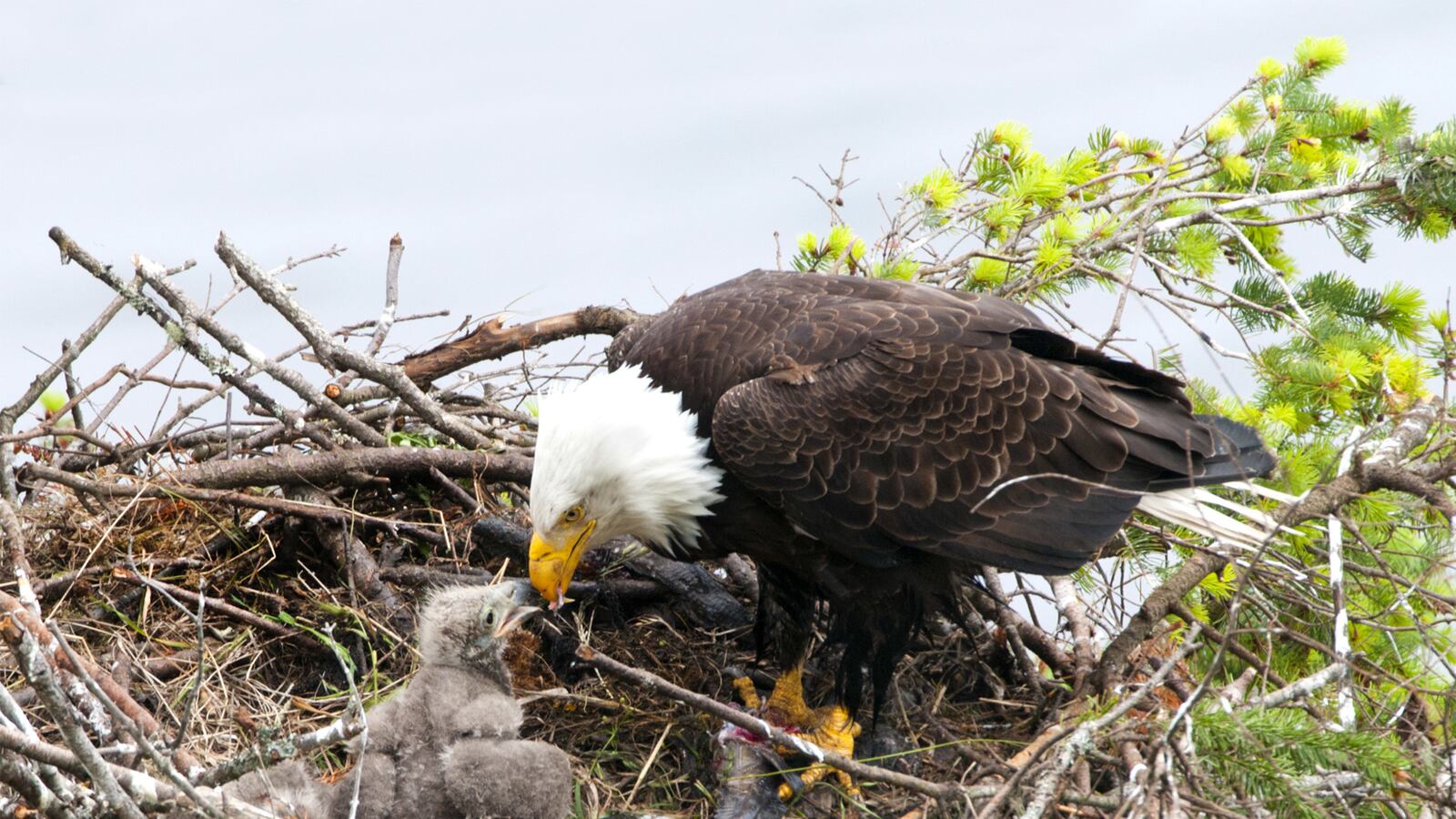The two eaglets almost certainly would have died after a big storm wrecked their nest last year.
But the judge in La Salle County, Illinois, ruled that the only legal issue was whether Steve Patterson of Oglisby had violated a state law that prohibited him from taking bald eagles, even if it was only to prevent two injured and helpless eaglets from falling victim to predators.
Never mind that Patterson had simply been acting out of the very love for wildlife that had led him to take up nature photography in the first place.
When the case went to trial earlier this month, the jury was not allowed to hear expert witnesses who were prepared to testify that Patterson had saved the eaglets from suffering the fate of a sibling that had vanished following the spill from the nest.
Even so, at least one juror apparently balked at convicting a man for violating wildlife protection laws by protecting wildlife. The juror is said to have invoked common sense in the face of the statutes as codified by the State of Illinois.
“There was one person that stood up and said, ‘I don’t care what the law is. This guy saved two birds. … The law’s made to protect eagles and that’s what he was doing,’” Patterson says.
After deliberating for just under four hours, the jurors informed the judge that they were unable to reach a verdict. He sent them back to the jury room, but after an hour he accepted they were deadlocked and declared a mistrial.
The prosecution continued to take the position that the law is the law and on Wednesday it officially informed the court that it intended to retry the case. A new trial is set for early next year. A new jury will hear of the nest a pair of bald eagles built atop a dead tree after Frisbee-playing students drove them from their previous roost in a pine tree on the campus of Illinois Valley Community College on the other side of Route 251.
In the spring of 2013, the nest held three eaglets. Patterson lives nearby and he got a nice photograph of one of them at a week or two old being fed by a parent. He took another picture of two of them at two or three weeks.
Patterson was driving by the nest at the start of June when he saw that part of it was down, apparently as result of a storm that had swept through a few days before. He continued on to tend to his elderly father, but stopped on the way back.
When he approached the wrecked nest, Patterson saw one of the eaglets on the exposed ground near the base of the tree. He would later learn that the bird was a female. She was now eight weeks old, nearly full grown, but still at least a month from being of an age to take her first flight. She would not have been able to fly anyway. Her left wing was drooping, clearly injured.
The eaglet gazed back at him as her parents wheeled overhead, protective, but not likely able to protect her should a predator of any considerable size come along. The eaglet herself would not be able to put up much of a fight.
“They don’t know how to defend themselves,” Patterson says. “They’re so used to being in the nest.”
And she would not likely be able to flee.
“Eagles don’t walk real swell anyway, but with a broken wing, they don’t walk much at all,” Patterson says.
Patterson was certain this grounded youngster would not survive if he just left her there. Even eagles that are raised without event and master flying before quitting the nest only have about a one in 10 chance of reaching full adulthood and acquiring that distinctive white head.
Patterson headed home and returned with everything he figured he would need.
“Hard hat…heavy jacket…welding gloves…fish landing net…a sheet…a big Tupperware bin with a lid,” he says.
Patterson secured the permission of the landowner to venture onto the property. The hard hat was to protect him should the parents swoop low.
“Mom and dad were overhead squawking,” Patterson recalls.
The jacket and gloves were a precaution in the event the eaglet panicked, but there was little fuss as he tossed the net over her. She went as calm as a hooded falcon after he covered her head with the sheet.
In a few moments, the eaglet was in the bin and on her way to Patterson’s garage. He had been a Union carpenter for 30 years before retiring and devoting himself to nature photography. He had a perfect perch to keep her off the floor.
“A sawhorse,” he says.
With that eaglet out of harm’s way, Patterson headed back to search for her two siblings. He found one, a male, maybe 50 yards from the nest with no obvious injuries.
“He could hop around a little bit,” Patterson says. “But not much.”
Patterson would later learn that this one also had a fractured wing. But even if the eaglet had escaped unscathed from the tumble from the tree, he would have been nearly as helpless as his sister.
“An eagle’s main defense is its ability to fly and at eight weeks they don’t have it,” Patterson says.
And an eaglet does not start off flying from the ground, but from the nest.
“The first flight is more or less a glide,” he notes.
Patterson soon had the second bird in the garage.
“Another saw horse,” he says.
He had not seen the third eaglet and he did not want to wait before summoning help for the two he had been able to rescue. He called a wildlife rehab person at the community college to whom he had taken birds other than eagles in the past. She did not answer and he left a message.
He then tried to contact the Illinois Department of Natural Resources (DNR) only to learn that the local office had been closed due to flooding. He next contacted the local Oglisby police via 911.
“They were sort of laughing at me for calling 911, but I’ve been laughed at before,” Patterson says.
He then spoke to the state police, who proved to be aware of the fallen nest.
“They go, ‘That came down four days ago,’” Patterson says.
He was finally able to speak to DNR.
“They go, ‘We’ve been monitoring the nest and checking on them,’” Patterson recalls. “I said, ‘Well, there’s two of them on the ground. I was just there.’ They say, ‘If we catch you out there, we’re going to write you a summons. Leave them alone.’”
And that seemed to be that.
“I realized that conversation is done,’” he remembers. “So, I didn’t mention then that I had them in the garage. They were going to write me up if I even went out there.”
Patterson did not imagine that he was doing anything but what was right in every sense.
“I hadn’t even given a thought that I was breaking the law,” Patterson says. “I’ve been around these birds so much.”
The eaglets were still paramount in his mind and he called the Flint Creek Wildlife Rehabilitation Center in the suburbs of Chicago. The center had rehabilitated eaglets before and had recently released one back into the wild with apparent success. The center had seemingly proven wrong people who contend that rescued eaglets can only survive in captivity.
Flint Creek volunteers arrived and found the female of the rescued pair lying on the garage floor, dehydrated and malnourished from the four days on the ground after the nest collapsed. Her broken wing had begun to calcify at the break, but the center had to feed and hydrate her for two days before she was well enough for surgery. The wing was reset with a pin that was later removed.
The rescued male was in better condition and his fractured wing began to heal without surgery. The third eaglet was never found despite a search by the Flint Creek volunteers and the landowner.
Patterson here discerned mathematic proof that the others would have suffered the same fate.
“There’s no probably about it,” Patterson says. “There’s only two left. One of them was gone already.”
Four days later, cops from the town police, the DNR and the U.S. Fish and Wildlife Service appeared at Patterson’s house. He was at a friend’s house and the cops went looking for him there.
“They started interrogating me and I told them the whole story, step by step,” Patterson says. “And didn’t leave anything out.”
The Fish and Wildlife officer told him that it was illegal to possess a protected species or a raptor.
“I go, ‘I couldn’t leave them there to die,’” Patterson recalls. “He said, ‘What we do is just let nature take its course.’”
The cops told Patterson that they had been monitoring the situation and had everything under control. Patterson decided that meant they just left the eaglets at the mercy of whatever danger arose.
“They did nothing,” Patterson says.
With regards to Patterson, the cops ended up issuing him four citations, two per eaglet. He was charged with two counts of possessing a raptor and two counts of possessing a protected species.
He technically faced as much as a year in jail and thousands of dollars in fines. He could have gotten away with a greatly reduced fine and no time behind bears if he had simply entered a guilty plea.
“But it would have been on my record,” Patterson says. “I’m an outdoor wildlife photographer, I don’t need my name slammed. Because I don’t mistreat wildlife. I love it. That’s what I do.”
Patterson decided to fight the charges and retained a lawyer, even though that was sure to cost a great deal more than the fines he could have paid just to walk away.
“The first lawyer wasn’t much of an outdoorsman, so I had to get a lawyer who knew a little bit about wildlife,” Patterson says.
The DNR and the prosecutor spoke of Patterson as if he were an eaglet-napper and reported that he had once been cited for “baiting” owls. He allows that he was ticketed for “harassing wildlife” after some hardcore bird watchers complained that he was interfering with their activities by using mice to draw owls. His sole intent was to take photos.
“I like owls,” he says.
In rescuing the eaglets, Patterson had considerable popular support. An online petition on his behalf collected more than 50,000 signatures.
At the trial, the judge barred Patterson’s lawyer from offering what is known as a “necessity defense,” where a person is left with no choice but to break the law in order to save a life. The jury never got to hear what Patterson’s expert witnesses told the judge.
“They said, ‘He saved these birds,’” Patterson says.
But that truth was implicit enough that it apparently arose during the jury’s deliberations. The result was the deadlock leading to the mistrial.
The new trail is slated for February, which happens to be around the time the eagles will likely be starting another brood. They have a new nest in a tree back on the campus of the community college, whose sports teams happen to be named the Eagles.
By then, the less seriously injured of the two eaglets is expected to be released. The other is still on the mend, but was doing well the last Patterson heard.
“She’s looking real good,” Patterson says.






